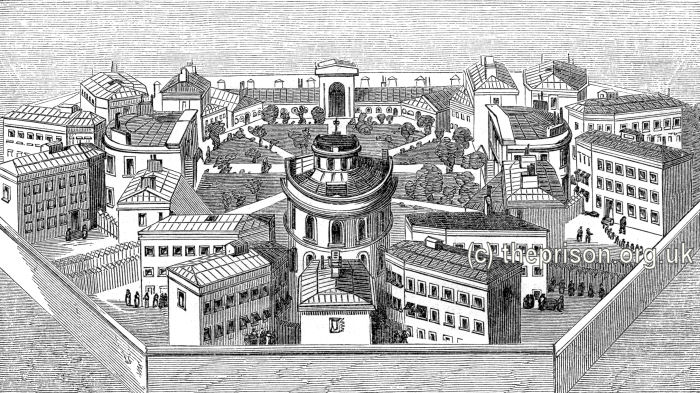Bridewells
The original Bridewell started life as a palace built by Henry VIII on the west bank of London's River Fleet. In 1553, Edward VI handed over the site to the City authorities as a 'house of occupation' for idlers, vagrants, and prostitutes. Bridewell was rather different from other penal establishments in being part of the poor relief system rather than the criminal justice system. Its aims were to reform the idle and disorderly, to make them earn their keep, and to deter others from indolence. The costs of running Bridewell were largely met from a tax on local inhabitants rather than fees extracted from the inmates who were mostly penniless.
For the more industrious inmates, productive work was available using materials provided by City merchants. Those who were classed as 'sturdy' (i.e. able-bodied) beggars were required to work, and were fed on a 'thin diet onely sufficing to sustaine them in health'. Repeat offenders could be whipped, and were given hard labour such as beating hemp.
The 1576 Poor Act adopted Bridewell's model and proposed the establishment a 'house of correction' in each county to deal with the able-bodied poor who refused to work. Every county had at least one bridewell operating by 1630. Houses of correction (also known as bridewells after the original London establishment) were supervised by Justices of the Peace (JPs) and their costs supported from the local poor rates.

The Tothill Fields House of Correction, Westminster, 1860s. © Peter Higginbotham
Bridewells were often located adjacent to workhouses, or even formed part of the same building. At Yarmouth, the town bridewell stood in the workhouse yard and consisted of four sleeping cells inside which prisoners were attached by a five-foot chain to an iron staple in the floor. Calls of nature were carried out via a wooden tub which was emptied when nearly full.
Despite the original intention for houses of correction to be reforming institutions for the idle and disorderly, by the end of the seventeenth century their poor law function had effectively ceased and they had become places of punishment for all manner of petty offenders. Their operation was increasingly carried out on a commercial basis, with the inmates' labour being used to contribute to the cost of their maintenance and to their keeper's income.
The fact that houses of correction had become little different from other 'common' local gaols was recognised in a 1720 Act which empowered JPs to send vagrants and other minor offenders to a house of correction or to a common town gaol as they felt fit. There remained some technical differences between the two institutions — a debtor could only be placed in a common gaol, and a vagrant only in a house of correction — until both were re-designated as Local Prisons in 1865.
Bibliography
- Higginbotham, Peter The Prison Cookbook: A History of the English Prison and its Food (2010, The History Press)
- Brodie, A. Behind Bars - The Hidden Architecture of England's Prisons (2000, English Heritage)
- Brodie, A., Croom, J. & Davies, J.O. English Prisons: An Architectural History (2002, English Heritage)
- Harding, C., Hines, B., Ireland, R., Rawlings, P. Imprisonment in England and Wales (1985, Croom Helm)
- McConville, Sean A History of English Prison Administration: Volume I 1750-1877 (1981, Routledge & Kegan Paul)
- Morris, N. and Rothman, D.G. (eds.) The Oxfod History of the Prison (1997, OUP)
- Pugh R.B. Imprisonment in Medieval England (1968, CUP)
Links
- Prison Oracle - resources those involved in present-day UK prisons.
- GOV.UK - UK Government's information on sentencing, probation and support for families.
Except where indicated, this page () © Peter Higginbotham. Contents may not be reproduced without permission.



